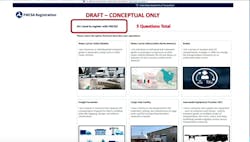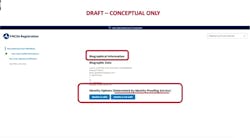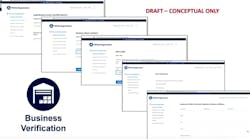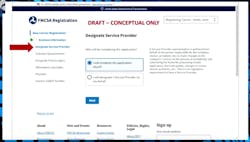Registration through the Federal Motor Carrier Safety Administration can require interstate carriers to juggle multiple disparate paper forms in a complicated and mind-bending process. To make things easier for carriers, FMCSA is building a new online registration system to replace its outdated protocol.
The administration is promoting its solution as a streamlined, intuitive, one-stop registration system—one that could replace both paper forms and its half-implemented Unified Registration System.
“It will consolidate all our forms into one online application, which will also allow us to retire some of our legacy IT systems. So: one system, one online form, one database,” Ken Riddle, director of FMCSA’s Office of Registration and Safety Information, said.
This week, FMCSA officials shared what the new registration process would look like. Riddle showed a mockup of the new system and shared some new agency actions to mitigate fraud in a webinar on May 28.
See also: Future models: OEMs, startups show off new trucks and vans at ACT Expo
The new FMCSA registration system
Riddle shared an outline of the questions, fields, and processes that will be included in the final system. He provided screenshots of the system’s conceptual mockups, stressing that they will not reflect the look of the final platform.
“Today is more about showing you some of the functionality we’re building, not necessarily the look of what we’re building,” Riddle said.
Pre-registration
First, Riddle showed off a tool to help users decide whether they should register at all. The tool—“Do I need to register with FMCSA?”—would present questions to determine if registration is necessary. Questions could include “Please select the option that best describes your operations” followed by answer options ranging from motor carrier to freight forwarder.
After this process, the platform will tell the user whether they need to register. It will then provide a registration checklist outlining all the information and documentation they may need to register: company information, business agreements, login.gov account, etc.
The registration process
The registrants themselves would begin the process by submitting profile information, undergoing user identity verification, and providing business information.
The new process is a significant departure from the current registration process, where service providers can handle all of the carrier’s registration. Under the new platform, registrants will be directly responsible for the beginning and final steps of their registration.
Profile information would include basic fields like first name, last name, address, etc. However, FMCSA doesn’t yet know what the identity verification will look like. The administration is still selecting a vendor for new identity and business verification processes.
“We don’t have the service yet, but we soon will. We will sit down with the vendor and we’ll figure out how this interface is going to work,” Riddle said. “But the bottom line is: every individual registering with FMCSA will have to go through this identity proofing service and prove they are who they say they are before being allowed to continue.”
Business information would include fields such as legal business names, business phone numbers, and the names and titles of officers.
After all these steps, the registrants will be able to designate a service provider to complete the next major part of the application: providing finer business details like registration type, motor carrier type, company operations, vehicle specifications, and driver information.
Next, the registrant or service provider chooses a blanket BOC-3 company as necessary. The BOC-3 company would provide the registrant/provider an account number to invite them to complete the application. The new BOC-3 selection is a notable difference from FMCSA’s current protocol, where the blanket company files on behalf of the carrier.
At this point, the registrant alone must finish the application process to fill out certification statements, oaths, and fee payments. The service provider would not be able to manage these steps.
Then, the registrant is mostly done with the registration process. In the new platform, they would see the status of their registration. This status will first, generally, be an inactive US DOT number. The page will tell users what else is required for active registration—ranging from administration filings to challenges.
Users can return to the platform to look at their account information, see their business info, registrations and statuses, insurance info, blanket company, and more.
“All of this is going to be built mobile-friendly and device agnostic,” Riddle said.
Updates to combat fraud
Riddle also took time to share updates to FMCSA’s registration processes designed to mitigate fraud.
“We cannot wait; we need to do what we can to help the industry mitigate the fraud that’s occurring today,” Riddle said.
He announced that five new fraud prevention measures are already underway:
- The administration suspended the ability to get a PIN online because the option was vulnerable to exploitation, Riddle said. FMCSA will now only mail PIN numbers to carriers’ addresses.
- FMCSA implemented multi-factor authentication to mitigate unauthorized access to login.gov
- The administration is requesting a copy of driver's licenses in paper application submissions to better validate account holders’ identities.
- FMCSA has tightened PPOB requirements and is now verifying businesses’ PPOBs.
- The administration is planning a Registration Fraud Team to identify ways FMCSA can mitigate registration fraud.
Riddle also shared that the administration is planning two new verification services to reduce fraud: identity verification services and business verification services.
“We are in the acquisition process of hiring a company that does this identity proofing,” Riddle said.
Details on these processes are still unknown—however, Riddle suggested that the identity verification process will likely require new applicants to upload a picture of their driver’s license and a selfie.
“With those two services—that capability—I think we can go a long ways towards mitigating some of the problems the industry is seeing today,” Riddle said.
About the Author
Jeremy Wolfe
Editor
Editor Jeremy Wolfe joined the FleetOwner team in February 2024. He graduated from the University of Wisconsin-Stevens Point with majors in English and Philosophy. He previously served as Editor for Endeavor Business Media's Water Group publications.





